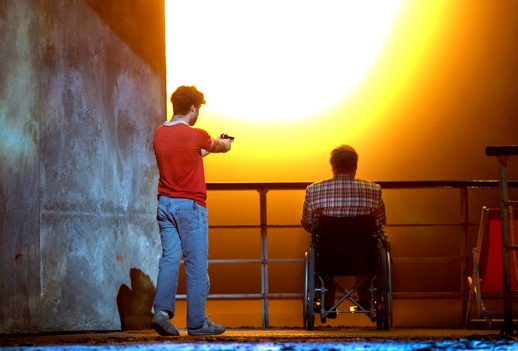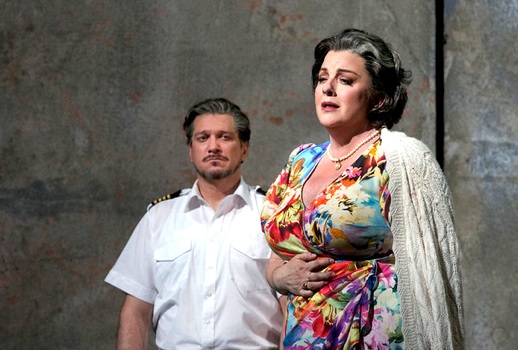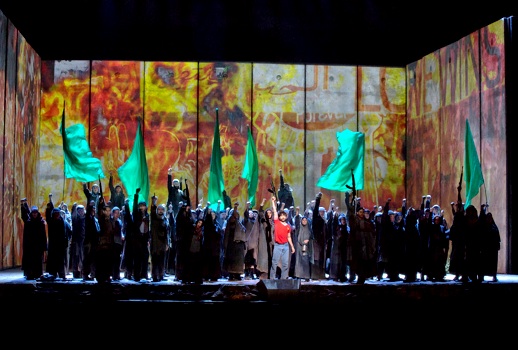It was a night a-tingle with excitement at the Metropolitan Opera House. At least part of this lay in never knowing when vocal protests might explode (verbally) somewhere in the auditorium.
The place was crawling with cops, the plaza itself largely cordoned off. There were two serious outbursts, a bunch of folks in the Orchestra level between the Prologue and Act I, and a lone but loud “We will never forgive the murder of Klinghoffer!” at the top of the Family Circle between two scenes of Act I. That both disturbances took place when no music was being performed I take as a sign of respect for the artists: No offense to them was intended. Good: They were terrific.
I do wonder if the problem is not that the name, Klinghoffer, is so very evocative and so very Jewish. If he’d been Leon Klein or Leon Jones, would anybody, hearing it, instantly remember the horrific event? And would a piece named for the murder raise such interest and such hackles? Peter Sellars, who proposed the idea to composer John Adams and librettist Alice Goodman, began with the title; he recognized that the name was sure-fire. It is! And every artist at work on a theater piece craves an alluring title. But fires sometimes scorch, though only heat and light were intended. Were they naïve not to expect controversy? They were—yet there have been 24 different productions of the piece.
The intent was to make use of a terrorist act, not even one of the truly bloody ones, to investigate the origins of terrorism as a choice, a tactic, a mind-set. This led them back to the dilemma at the origin of the Israel-Palestine conflict. Is this a worthwhile subject for art? Surely it is. Terrorism is as dangerous, as debated, as ill-understood a matter in our society as were the Rights of Man when Mozart wrote Le nozze di Figaro or the claims of national realization when Verdi wrote Nabucco—to which Klinghoffer bears a certain resemblance, in the primacy of its choruses and the irrelevance of much of its plot.
It is right and proper for artists to discuss such matters in their work, and proper for an institution as central as the Met to stage the results. Artistic argument does not pretend to solve problems, but that is not its function. The art may bring us to understand the situation in new ways.

A choral prologue begins the opera: Palestinian exiles, presumably living in refugee camps (the projection is of the barbarous wall that divides the West Bank from Israel), sing of their lost homes, their lost land, while the years pass against the back wall from 1948 long past the events of the opera, right up to 2014. This is followed by a chorus of Israelis telling a national creation myth, of a young man returning to an old, injured woman he still loves. Goodman’s verse, as always throughout the night, interweaves ancient notes, mythic notes, and modern notes.
One subtle poetic effect especially struck me: Goodman’s linking of bird imagery to certain points in the action: The terrorists mull the birds overhead, are they migrants or “if they live here.” Leon Klinghoffer, trying to make his worried wife smile, asks if she thinks a gull will land in the swimming pool. When the helpless Captain breaks the news of Leon’s death to Marilyn, he calls her a rara avis for a bravery she isn’t in the mood to feel.
Then we are in an auditorium, years after the Achille Lauro hijacking. Half a dozen survivors tell their tales, led by the Captain (Paulo Szot—our guide, our representative, our observing self, excellent company in all these roles). Tom Pye’s set is functionally inventive (bits of shipboard, staircase, railing, saloon), but mainly serves as a platform for Finn Ross’s astonishing projected films (much trailing surf behind the liner, sunsets, walls, staterooms) and Jean Kalman’s intricate lighting. This production would look superb in HD, and I deeply regret the Met’s decision (after debate with the Anti-Defamation League) to cancel that. I hope they will tape it anyway for future broadcast.

The opening was my first exposure to the score. As with Adams’s other operas, I found myself attracted by his choral effects and enthralled by his use of the orchestra (conducted by David Robertson). Fascinating obbligatos and accompaniments singled out this or that instrument, eliding or sparring with the voice, oboes for the love songs a terrorist listens to on a transistor radio, flutes for the British dancing girl’s jolly memories, tingling harps here, somber horns there, subtle and ominous percussion. The melodies of the score seemed to come principally from the tonal blocks and Glass-like evolutions of the orchestra or from the words or wails of the chorus rather than from solo performers.
What I missed, in a great deal of this score as in Doctor Atomic, was song, the individual (or multiple) voice giving music to its character’s thought. In Act I, there seemed to be nothing but recitative declamation, and even the romantic radio-fed reflections of the sentimental terrorist Mamoud (Aubrey Allicock, a bass baritone debutante with a voice of pleasing color) came out as unmusical. I wondered (as I had in Doctor Atomic) if Adams’ style of opera was entirely orchestral-choral, the solo voices existing not to add musical texture or enact a drama but simply to put words to the musical matter that, however sublime, lacked specific reference.
In Act II, however, I began to settle in. Ryan Speedo Green, the appealingly dark-voiced bass-baritone (as Rambo) and the strapping tenor voice of Sean Panikkar (as Molqi) made the terrorist presence more immediate. The star terrorist, however, was the assassin Omar, performed by a wiry dancer, Jesse Kovarsky, whose thoughts we longed to understand as he worked himself up to murder, not much helped by an attractive aria for a Palestinian Woman (hoarsely sung by mezzo Maha Lahyani), who seemed to be urging him towards death as a step towards Paradise. (The intriguing choreography was by Arthur Pita.) But his motive was also made clear by Kovarsky’s subservient attitude in response to Green’s brusque, tough handing him the revolver: He was living up to an adult ideal, trying to obtain an illusion of the manhood stolen by his broken childhood.

Alan Opie, who rather specializes in peculiar dramatic roles, sings Leon Klinghoffer. His insulting denunciation of his tormentors (he is standing, tottering, and his wheelchair has been pulled away) seems almost to trade on his helplessness to challenge them. His voice takes on suppler tones when calming Marilyn. “We’ll come home with great tans.” He is given a posthumous aria, a meditation in flight, a symbolic puzzle. We never learn why he was the chosen victim. The terrorists threatened to kill a passenger every fifteen minutes until some nation allowed them to dock; after this one death, Syria opened its port. Was he the one who held the least attractive mirror up to them? Or the one who seemed most expendable? In any case, it is a heroic, exalting portrayal.
Marilyn Klinghoffer is Michaela Martens, whose outsize mezzo and dramatic power has long been in search of a proper outlet. The Met seems puzzled how to use her. (Alisa in Lucia? Really?) She got to sing one Kundry here. She should sing ten. She’s our next Dolora Zajick, and we could use one. Her Marilyn is always in character, though, the power restrained, but she gets the final word: She tells the consoling Captain she’d spit at him but her mouth is dry. He—and we—are entirely on her side by this point, but without negating the humanity of anyone else who has appeared on stage. Klinghoffer did not get to choose his death, and he doesn’t get to choose what his death symbolizes to others. The ending is abrupt, startling, a shock, a thrill. Ovations followed.
This is not opera told in the familiar terms. There is barely a “play” here; this is moody opera. The experience was not as successful for me as, for example, Glass’s Satyagraha, which had far more expressive vocal opportunities for its soloists and a single philosophic message to convey, but it is more satisfying than Doctor Atomic, with its brutal libretto and awkward conclusion. These are all oratorio-like operas, though Klinghoffer is the least dense in giving us characters who attempt to speak to us, as the observing world, a world they think their humanity can reach.
[This version of the review includes several paragraphs which were inadvertently omitted when it was first published.]
Photos: Ken Howard/Metropolitan Opera






Comments